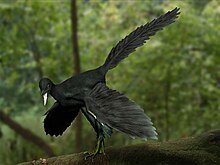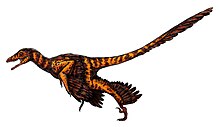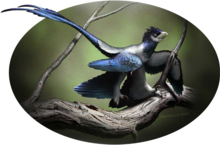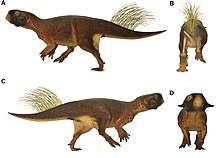Dinosaur coloration

Dinosaur coloration is generally one of the unknowns in the field of paleontology, as skin pigmentation is nearly always lost during the fossilization process. However, recent studies of feathered dinosaurs and skin impressions have shown the colour of some species can be inferred through the use of melanosomes, the colour-determining pigments within the feathers.
Feathered dinosaurs
Anchiornis

In 2010, paleontologists studied a well-preserved skeleton of Anchiornis, an averaptoran from the Tiaojishan Formation in China, and found melanosomes within its fossilized feathers. As different shaped melanosomes determine different colours, analysis of the melanosomes allowed the paleontologists to infer that Anchiornis had black, white and grey feathers all over its body and a crest of dark red or ochre feathers on its head.
In 2015, another specimen was reported to possess melanosomes that induced grey and black coloration, but no red or brown coloration. This may have been because of different testing methods or a different age or species of the second tested specimen.
Archaeopteryx

In 2012, Ryan Carney and colleagues produced the first colour study on an Archaeopteryx specimen. Fossilized melanosomes suggested a primarily black coloration in the feathers of the specimen. The feather studied was likely a covert, which would have partly covered the primary feathers on the wings. Carney pointed out that this is consistent with the flight feathers of modern birds, in which black melanosomes have structural properties that strengthen feathers for flight.
In 2013, a study published in the Journal of Analytical Atomic Spectrometry by Manning et al. reported new analyses on the feather revealing that Archaeopteryx may have had light and dark coloured plumage, with only the tips of the feathers being primarily black instead of the entire feather. Whether or not this coloration was primarily for display or flight is currently unknown.
A follow-up study by Carney and colleagues in 2020 suggested that the feather was matte black, not iridescent, with 90% probability, owing to the less elongated shape of the melanosomes. However, they noted that some of the melanosomes preserved three-dimensionally in the specimen were distorted to give the impression of iridescent melanosomes. Unlike Manning and colleagues, they reconstructed the feather as being completely dark at the tip.
Beipiaosaurus

Beipiaosaurus had a dense covering of downy-like fibers along with a secondary coat of longer, simpler feathers. In a study of the colour and shape of fossilized melanosomes in numerous extant and fossil specimens, Li et al. (2014) found that the preserved feathers in the neck area of the Beipiaosaurus specimen implied brownish and dark brownish coloration.
Caihong

The fossilized feathers of Caihong possessed nanostructures which were analyzed and interpreted as melanosomes. They showed similarity to organelles that produce a black iridescent colour in extant birds. Other feathers found on the head, chest, and the base of the tail preserve flattened sheets of platelet-like melanosomes very similar in shape to those which create brightly coloured iridescent hues in the feathers of modern hummingbirds. However, these structures are seemingly solid and lack air bubbles, and thus are internally more akin to the melanosomes in trumpeters than hummingbirds. Caihong represents the oldest known evidence of platelet-like melanosomes.
Caudipteryx

In the 1998 description of Caudipteryx, Qiang et al. noted the existence of preserved colour bands on the fossilized tail feathers of the holotype specimen. Later studies indicated that the body feathers of Caudipteryx contained eumelanin, a pigment lending dark grey/black shades.
Microraptor

In 2012, Quanguo Li and colleagues analyzed BMNHC PH881, a specimen of Microraptor, and determined that the coloration of typical Microraptor feathers was iridescent black. The melanosomes were narrow and arranged in stacked layers, reminiscent of the blackbird. It was believed that Microraptor was nocturnal due to size of the scleral ring. However, the iridescent nature of its feathers has cast this into doubt, since no modern birds with iridescent plumage are known to be nocturnal.
Sinornithosaurus

In 2010, a team of researchers analyzed the holotype remains of Sinornithosaurus (IVPP V12811) and other feathered dinosaurs from the Yixian and discovered melanosomes. The presence of rod- and spherical-shaped melanosomes suggested that Sinornithosaurus had black and rufous feathers. Unfortunately, the exact location of these colours on the body is unknown, so the colour pattern cannot confidently be determined.
Sinosauropteryx

Zhang et al. (2010) discovered melanosomes in the remains of Sinosauropteryx and some other feathered dinosaurs. It was determined that Sinosauropteryx had rufous/light brown feathers and that its tail was striped. Given the feathers were brightly coloured and ill-suited for flight, it was hypothesised that this species used its feathers for display. A 2017 study by Smithwick et al. also reported that the body coloration of Sinosauropteryx extended to the face, creating a raccoon-like "mask" around the eyes. They hypothesized that the countershaded pattern of Sinosauropteryx likely acted as camouflage in an open environment.
Wulong

In 2023, Croudace et al. described the likely plumage coloration of the Wulong holotype, a complete articulated specimen of a one-year-old individual. They proposed that the feathers on the forelimbs and hindlimbs were iridescent, with feathers on the rest of the body being grey. They suggested that, since the Wulong holotype is a juvenile, the iridescence may indicate purposes of intraspecific signalling and communication, rather than solely sexual signalling.
Prehistoric avians
Bohaiornithid (CUGB P1202)
An unnamed bohaiornithid enantiornithine specimen preserved on a slab and counterslab was described in 2016 by Peteya et al. Their analysis of the extensive covering of fossilized feathers suggested that the crown, neck, and body contour feathers were weakly iridescent.
Calciavis
In a 2020 study, Eliason and Clarke determined that the feathers on the head, tail, and wing primaries of the Eocene lithornithid Calciavis were iridescent, likely glossy black. Additionally tested feathers from the fossilized wings were black.
Changzuiornis
In their 2016 description of the Early Cretaceous ornithuran bird Changzuiornis, Huang et al. noted melanosomes indicative of black coloration in the fossilized feathers of the wings and leg/tail region.
Confuciusornis


In 2010, Zhang et al. examined fossils of feathered dinosaurs with preserved melanosomes. After studying these with an electron microscope, they found eumelanosomes and pheomelanosomes preserved in a specimen of Confuciusornis, (IVPP V13171). This suggested that Confuciusornis had hues of grey, red/brown and black. This was the first time that an early bird fossil had been shown to contain preserved pheomelanosomes. However, Wogelius et al. (2011) failed to find these reported traces of pheomelanosomes. They found a link between the presence of certain metals like copper, and preserved melanin. Using a combination of preserved melanosomes and metals in the feathers, they reconstructed Confuciusornis sanctus with dark-coloured body and upper wing feathers, but found no trace of either melanosomes or metals in the majority of the wing feathers. They suggested that the wings of Confuciusornis may have been white or coloured with carotenoid pigments. The long tail feathers of male specimens would have also been darker in colour.
In 2018, Li et al. reported extensively preserved melanosomes and plumage patterns in the fossilized feathers of another specimen (CUGB P1401) of a species of Confuciusornis. They noted primarily dark colours with the feathers on the wings, covert feathers, crest, and throat having complex patterns of small dark spots. Comparing the preserved patterns of Confuciusornis with extant birds, they further suggested that this pattern was used as camouflage.
Cruralispennia

Structures believed to be fossilized melanosomes were found in five feather samples from the only known specimen of the enantiornithean bird Cruralispennia using scanning electron microscopy. Due to their rod-like shape, they were identified as eumelanosomes, which correspond to dark shades. Although specific colours were not stated in the analysis, other studies have shown that coloration in extant birds correlates to the length and aspect ratio (length to width ratio) of their eumelanosomes. A sample taken from the crural feathers had eumelanosomes with the shortest aspect ratio, which may have corresponded to dark brown coloration. The highest aspect ratio eumelanosomes were found in a sample from the head feathers. High aspect ratios have been known to correlate with glossy or iridescent colours, although without knowing the structure of a feather's keratin layer (which does not fossilize well), no hue can be assigned for certain. The wing and tail samples also had high aspect ratios, while the tail's eumelanosomes were the largest sampled.
Eoconfuciusornis

Zheng et al. determined the likely colours of a specimen of Eoconfuciusornis in 2017. They suggested that the feathers of the wing coverts, nape, and tail were black, the feathers on the leg and top of the head were grey, and the feathers on the throat were brown. The secondary remiges had a dark spotted pattern.
Eocoracias

In 2019, Babarović et al. studied a specimen of the Eocene coraciiform Eocoracias. They observed non-iridescent structural coloration on its feathers, the first time such has been found in a bird fossil. They reconstructed parts of the neck, tail and rump of Eocoracias as black, with the rest of the body plumage being blue. The wing feathers were also black and blue.
Eocypselus
In 2013, Daniel T. Ksepka et al. described a new species of the Eocene bird Eocypselus, E. rowei from the Green River Formation. The holotype specimen, prserved on a slab and counterslab, contains fossilized feather imprints. Ksepka et al. tested the feathers on the top of the head for preserved melanosomes, and noted densely-packed, rod-like eumelanosomes, which typically create iridescent black colours.
Inkayacu

The melanosomes within the feathers of the Eocene penguin Inkayacu are long and narrow, similar to most birds. Their shape suggests that Inkayacu had grey and reddish-brown feathering across its body. Most modern penguins have melanosomes that are of similar length to those of Inkayacu, but are much wider. There are also a greater number of them within living penguins' cells. The shape of these melanosomes gives them a dark brown or black colour, and is the reason why modern penguins are mostly black and white.
Iteravis
Wang et al. (2018) analyzed the elongate, closely-spaced melanosomes preserved in the feathers of a specimen of the Early Cretaceous ornithurine Iteravis to determine that they were likely black in colour.
Messelornis
A single fossilized feather, likely belonging to Messelornis, was described in 2015 by Colleary et al. They suggested that the feather, likely coming from the wing, would probably have been iridescent in life.
Pellornis
In 2019, Musser, Ksepka & Field determined that a long feather from the tail of the Eocene bird Pellornis would have been a black-brown colour.
Primotrogon
Grey and iridescent colours were detected in a specimen of cf. Primotrogon sp., an Eocene trogon, by Nordén et al. in 2018. They note that the grey feathers could be down, which is often seen in shades of grey or white, so the colour patterns of Primotrogon cannot be confidently determined.
Protopteryx

In a 2020 study by O'Connor et al., they analyzed a wing feather of the Early Cretaceous enantiornithean Protopteryx and found evidence of eumelanosomes, suggesting that it had black, non-iridescent feathers.
Scaniacypselus

Nordén et al. (2018) studied two specimens of the Eocene swift Scaniacypselus szarskii. They primarily observed grey and brown colours, and noted that it likely had no iridescent feathers.
Yuanchuavis

In their 2021 description of the Early Cretaceous pengornithid Yuanchuavis, Wang et al. described the presence of eumelanosomes in the preserved tail feathers. The paired central rectrices are dark, while the smaller feathers are non-iridescent, likely grey.
Non-feathered dinosaurs
Borealopelta

A 2017 examination of melanosomes preserved in a specimen of Borealopelta indicated that the nodosaurid had a reddish-brown coloration in life, with a counter-shaded pattern that may have been used for camouflage. This discovery may indicate that Borealopelta was under threat of predation, despite its large size, and that the armor on its back was primarily used for defensive rather than display purposes.
Hadrosaur (YPMPU 016969)

A 2020 examination of a sample of 3D preserved fossil skin (YPMPU 016969) from the flank of a hadrosaurid revealed the presence of eumelanin in the specimen. Fabbri et al. hypothesized that this may suggest a grey colour, comparable to the skin of extant rhinoceros and elephants. This coloration may further imply that some hadrosaurs occupied similar ecological niches to large modern mammals.
Psittacosaurus

In 2016, examination of melanosomes preserved in the integument of a specimen of Psittacosaurus sp. indicated that the animal was countershaded, with stripes and spots on the limbs for disruptive coloration. This is similar to that of many modern species of forest-dwelling deer and antelope and may be due to a preference for a densely forested habitat with low light. The specimen also had dense clusters of pigment on its shoulders, face (possibly for display), and cloaca (which may have had an antimicrobial function).